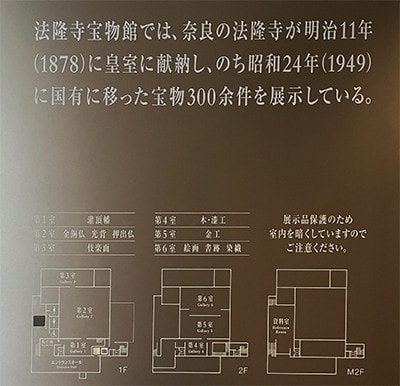

地方にいていちばん「格差」を感じざるを得ないのが、芸術とか文化性との距離感。面白いと思える展覧会とか、希少な展示などが地方で開かれる、公開されるというのはほぼない。
日本人に生まれて多少なりとも歴史とかに興味を持てば、法隆寺の宝物というものには一度は触れてみたいと思うものだと思います。まぁもちろん東京や近郊に住んでいても、興味がなければ行かないだろうけれど(笑)。わたしは上野の東京国立博物館での企画展示などは機会があれば、参観しています。
しかし、公園敷地のやや奥まった位置にあるこの「法隆寺宝物館」には足を運んでいなかった。先日、はじめてこの建物と遭遇して、内部も参観することができました。
建物は水盤越しに端正なモダニズムの外観で迎えてくれる。水盤の右側中央に動線通路があって、通っていくとちょっとした「結界」を感じさせてくれる。


シンプルなコンクリート建築で水盤に向かって大きく開口部があけられている。静謐な雰囲気を表現し展示物との出会いを坦々と演出してくれている。建築と展示の目的は案内写真の通り。
さすがに国家的な文化展示なので、写真撮影はストロボなどの手法を使わなければ、自由にできる。確認してから写真撮影させていただいた。その展示物写真群を自宅でときどき見返してみる機縁をいただけるのはたいへんありがたい。現物と接してそのあと、丹念にその情報を反芻して深く理解できるというのは素晴らしい体験機会。
ちょうど聖徳太子に関する「絵伝」をデジタル技術を活用して展示していて、強く興味を惹かれた。日本人がふつうにリスペクトしてきた精神性部分がこういった展示物には凝集されているのでしょう。
建築としては訪問者の心理をしずかに落ち着かせるような仕掛けを感じさせられました。
いろいろな機能性が建築にはあるでしょうが、これはこれ。日本人と法隆寺という関係性には似つかわしい空間性だったように思います。展示物の参観に十分集中することができました。
PS:昨日6回目のワクチン接種。いろいろ考え方もあるでしょうが、わたし自身としては加齢のこともあり、社会的にご迷惑を掛けないようにと受けた次第。副反応の軽微なることを願う次第。
English version⬇
Exploring the Neat Modernism of the Gallery of Horyuji Treasures
Japanese people have had a long relationship with Buddhism. The treasures in the museum are a collection of the history of Buddhism. The treasures are an opportunity to talk with the ancestors who believed in Buddhism rather than to talk with the treasures. The Treasure House of Horyuji Temple
One of the biggest "disparities" I feel when I am in a rural area is the distance between art and culture. There are almost no interesting or rare exhibitions held or exhibited in the countryside.
If you are Japanese and have some interest in history, you would like to see the treasures of Horyuji at least once. Of course, even if you live in Tokyo or the suburbs, you probably wouldn't go if you weren't interested (laughs). I visit the special exhibitions at the Tokyo National Museum in Ueno whenever I have the chance.
However, I had not visited the Gallery of Horyuji Treasures, which is located in a slightly secluded part of the park grounds. The other day, I encountered this building for the first time and was able to visit the interior as well.
The building greets visitors with a neat modernist exterior over a water basin. There is a flow passage in the center of the right side of the water basin, which gives you a bit of a "boundary" as you walk through.
It is a simple concrete structure with a large opening toward the water table. It expresses a tranquil atmosphere and provides a peaceful encounter with the exhibits. The purpose of the architecture and exhibits is as shown in the guide photo.
As this is indeed a national cultural exhibition, visitors are free to take photos as long as they do not use strobe lights or other techniques. I was allowed to take pictures after checking it out. I was very grateful to have the opportunity to look back at the photos of the exhibits from time to time at home. It is a wonderful experience to be able to come in contact with the actual objects and then carefully ruminate on the information and understand it in depth.
I was fascinated by the exhibition of the "Pictorial Biographies of Prince Shotoku," which utilizes digital technology. I believe that the spirituality that Japanese people have usually respected is concentrated in such exhibits.
As for the architecture, I felt that it was designed to calm the visitor's mind.
There may be various functionalities in architecture, but this is one of them. I think the spatiality was appropriate for the relationship between the Japanese people and Horyu-ji Temple. I was able to fully concentrate on visiting the exhibits.
PS: Yesterday I was vaccinated for the sixth time. I am sure there are various ways of thinking about it, but for myself, I received the vaccine because of my aging and in order not to cause any inconvenience to the society. I hope that the adverse reactions will be minimal.



















